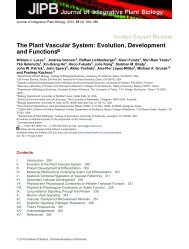Insights into the Witheringia solanacea (Solanaceae ... - BioOne
Insights into the Witheringia solanacea (Solanaceae ... - BioOne
Insights into the Witheringia solanacea (Solanaceae ... - BioOne
You also want an ePaper? Increase the reach of your titles
YUMPU automatically turns print PDFs into web optimized ePapers that Google loves.
Crossing Studies in Wi<strong>the</strong>ringia 75<br />
TABLE 3. Pollen stainability of Wi<strong>the</strong>ringia parents and hybrids. Abbreviations for accessions follow Figures 2 and 3.<br />
Parents<br />
ast 3007<br />
ast 2377<br />
mei 3015<br />
mei 2387<br />
sol 2427<br />
sol 2416<br />
No. flowers No. plants Mean percent (SD) Range (%)<br />
7<br />
6<br />
25<br />
10<br />
9<br />
6<br />
4<br />
3<br />
5<br />
2<br />
8<br />
3<br />
90.7 (6.8)<br />
93.9 (2.4)<br />
80.9 (13.7)<br />
94.3 (7.3)<br />
84.3 (12.6)<br />
83.7 (12.8)<br />
83–99<br />
90–97<br />
27–94<br />
77–99<br />
54–97<br />
68–99<br />
Overall 63 25 86.1 (12.2) 27–99<br />
Hybrids<br />
ast 3007 sol 2427<br />
ast 2377 sol 2427<br />
sol 2427 ast 3007<br />
sol 2427 ast 2377<br />
sol 2427 mei 2387<br />
10<br />
4<br />
5<br />
5<br />
5<br />
5<br />
4<br />
5<br />
4<br />
1<br />
57.3 (5.2)<br />
71.6 (5.9)<br />
57.9 (10.5)<br />
67.0 (6.0)<br />
62.6 (2.8)<br />
50–66<br />
65–79<br />
42–66<br />
58–75<br />
60–66<br />
Overall 29 19 61.9 (8.0) 42–79<br />
3007; W. meiantha: Bohs 3015; W. <strong>solanacea</strong>: Bohs<br />
2427) had N 12 chromosomes. Chromosomes<br />
at meiotic metaphase ranged from ca 1.5 to 3.5<br />
m long.<br />
POLLEN FERTILITY.—Results of <strong>the</strong> pollen stainability<br />
tests are given in Table 3. In general, all parent<br />
plants had high percentages of stainable pollen<br />
throughout <strong>the</strong> study. Mean pollen stainability in<br />
<strong>the</strong> hybrids was consistently lower than in <strong>the</strong> parental<br />
accessions (Table 3).<br />
FIGURE 2. Results of crossing study. Taxon abbreviations<br />
correspond to accessions listed in Tables 1 and 2;<br />
numbers 1 through 6 refer to same taxa in rows and<br />
columns. Minus sign no fruits produced; open circle<br />
full-sized fruits, but seeds not viable; filled circle <br />
full-sized fruits with viable seeds that subsequently produced<br />
F 1 plants. Intraspecific pollinations fall along diagonal<br />
line; space above line sib crosses or outcrossed,<br />
space below line selfed.<br />
BREEDING SYSTEM.—Both accessions of W. asterotricha<br />
and W. meiantha were SI, as judged by <strong>the</strong><br />
results of artificial pollinations and by pollen tube<br />
growth observations (Table 2; Figs. 2 and 3). No<br />
fruits were set by any plant upon self-pollination<br />
(Table 2; Fig. 2), although fruits and seeds frequently<br />
resulted from sib crosses or outcrosses. Several<br />
W. asterotricha and W. <strong>solanacea</strong> plants spontaneously<br />
developed small fruits that occasionally<br />
contained a few seeds. Numerous pollen tubes grew<br />
<strong>into</strong> <strong>the</strong> ovary and around <strong>the</strong> ovules in sib crosses<br />
and outcrosses in W. asterotricha and W. meiantha,<br />
but all tubes were inhibited in <strong>the</strong> style in self-<br />
FIGURE 3. Results of pollen tube observations. Taxon<br />
abbreviations as in Figure 2. Plus sign most pollen<br />
tubes reach ovary and ovules; plus/minus sign afew<br />
pollen tubes occasionally seen in ovary; minus sign all<br />
pollen tube growth arrested in style. Intraspecific pollinations<br />
are selfs. See Figure 2 for explanation of diagonal.
















